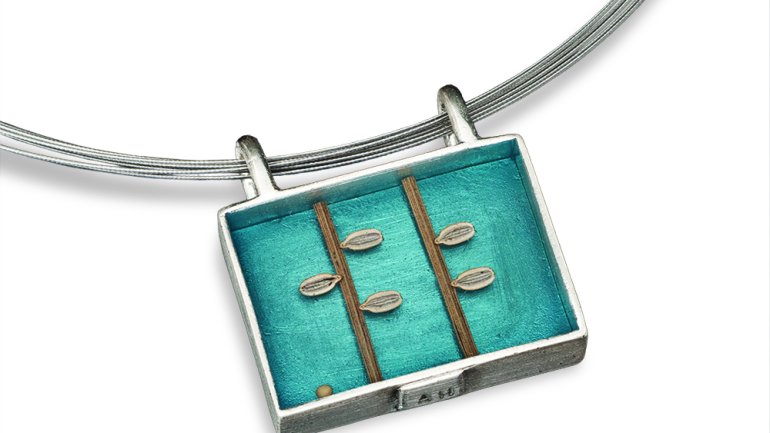Nature Squared
Nature Squared
Seventeen years ago, Andrea Haffner did something audacious, given her circumstances: She signed a lease on a studio in Washington, D.C. – a space she couldn’t yet afford.
“I knew I had the impulse to make,” she recalls. “Getting the studio and having to pay my rent forced me into the business of art. That was the beginning of developing a more rigorous attitude toward creating.”
That rigor has served her well. Today the 40-year-old is known for her evocative compositions of natural materials – yucca capsules and tulip stems, mustard seeds and hydrangea petals – suspended in pigmented polymer-based resin. She builds her jewelry in tiny sterling or gold frames; her wall sculptures hang on hooks in handsome steel enclosures.
Large or small, the result is striking: Her work is shown in galleries across the country, and she has been juried into many of the nation’s finest craft shows.
Haffner has always been artistic. She got her first camera as a 5-year-old. In high school, she studied photography and stained glass, processes that gratified her fascination with light and trained her eye to its effects on form. At Wesleyan University in Connecticut, she continued her art studies but opted for a “practical” degree in English literature. (“That was as practical as I could get,” she says.) After college, she moved to D.C., where she interned at a nonprofit arts organization.
There Haffner rented that catalytic studio, with its towering windows, brick walls, and wood beams. She began building boxes out of stained glass, creating compositions inside them with resin and natural materials. “All of a sudden, I was like: This little world is what I am interested in,” she says. “What’s inside this little box.” She had found her form.
As a child in Gallup, New Mexico, Haffner had fallen in love with the natural world, delighting in its wild variety. She loved little boxes and compartments, too, sensitive to the way containers can transform the objects placed within. In her spacious urban studio, everything clicked. “I don’t know if I would have come up with that combination [of nature and metal] if I had lived in a more natural environment,” she reflects. It’s a pairing that has sustained her for more than a decade.
Two and a half years ago, she left that Washington studio behind, relocating with her husband and son to Ojai, California. Part of the reason was to begin graduate work in depth psychology, which emphasizes the unconscious and the imagination. It’s a course of study Haffner describes as an extension of her artistic explorations, rather than a fork in her road. She now works in a 200-square-foot building behind her home, surrounded by a garden of succulents and shaded by enormous live oaks.
She collects materials for her sculpture and jewelry on hikes, observing on the way up, collecting on the way down. The method is deliberate; if she didn’t hold off on collecting until the return route, “I would never go anywhere,” she says.
Her collection fills half of her workspace. “I may have had some crooked little twig for 10 years, and then one day, it’s like, OK, it’s your turn.” Composition is Haffner’s favorite part of her work, though she’s also praised for her resin’s uncommon clarity, the result of a highly technical process perfected over years. (A single pendant can take several days to create, and that’s after she’s arranged its contents.)
She imagines herself never tiring of the process. “I love the full arc, from collecting these materials to eventually creating with them to sharing them,” she says.
That’s one reason she loves doing craft shows, she adds, along with her gallery and commission work.
“Meeting the person who is going to be taking a piece and hopefully finding a special place for it on their wall or wearing it – that’s the really gratifying part of what I do,” she says. “It’s kind of a ‘catch and release.’ ”
Julie K. Hanus is American Craft’s senior editor.

